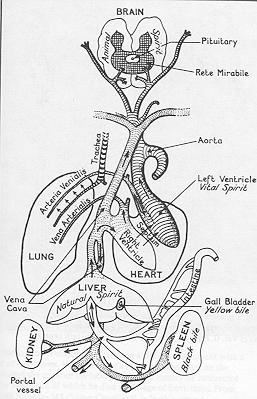Galen
Parts of the Circulatory System
In The Construction of the Embryo, Galen not only explores the workings
of the circulatory system, but he also describes how various parts acquire the
growth of various organs as the embryo develops. Unless stated otherwise, all
information cited was obtained from The Construction of the Embryo.
Liver:
Origin: According to Galen, the liver was the first
organ formed. The liver was created by the blood from the veins that entered
the embryo through what we know today as the umbilical cord. In Galen’s
ecological view of our development, he compared this system to a tree and
explained that the roots of the tree extracted nutrients from the mother’s
womb. The umbilical cord resembled a tree trunk in that arteries branched
out like limbs throughout the length of the body in order to provide nourishment.
Role: Galen believed the liver to be a part of
the circulatory system and the seed of the nutritive soul. Food that each
person consumes was digested and transported from the intestine through the
portal vein to the liver where blood was created. The blood was then utilized
and consumed by the various parts of the body.
Veins
Origin: Unlike the liver, the veins consist of
a substance differing greatly from blood and must have therefore been created
by the sperm after conception. (p.187)
Organs created by the veins: the liver, the mesenterion – which acquires
the stomach and the spleen – the intestines, the rectum, the omentum
(p.181), and kidneys (p.185)
Role: Galen believed that the veins carried material
nourishment from the liver to the rest of the body. Blood left the liver from
a large vein known as the vena cava to the right ventricle, where it traveled
from the chest and throat to the rest of the body. (pp. 184-185)
Arteries
Origin: Like the veins, the arteries were believed
to be created by the seed after conception.
Role: Arteries course throughout the entire body
and connect with the left ventricle of the heart. (p. 181)
According to “Galen Outline: On the Natural Faculties”, arteries
originate in the heart and transport a blood-like substance called pneuma,
which provides the vital life force to the body. Some of the pneuma is transported
to the brain, where it becomes a more purified form of pneuma that becomes
responsible for movement and sensation. (pp.3-4)
Arteries draw a blood-like substance (pneuma) which is considerably hotter
than the blood carried by the veins. This accounts for why the heart is so
much warmer than the liver. (p. 185)
This pneuma is a finer, warmer kind of blood, as evident when an artery is
injured. (p. 186)
If a limb or body part is ligated, everything above the ligation continues
to pulse, while anything below it does not. (pp. 189-190)
Hippocrates noticed that the vena cava – which he called the “hepatic
vein” – originated in the liver.
Heart
Origin: Created within the first few days of the
development of the embryo – after the liver and before the brain –
but does not provide a function vital to the initial formation of the liver.
(p.182)
Role: Only after the body has acquired all necessary
substances does the heart come into play and transform the body from a plant-like
substance into one that is more animal-like in nature. In the same time as
the heart pulses, it moves the arteries with the same motion. (p. 185)
The heart is a kind of furnace for the body (p. 185)
Hippocrates noticed that the vena cava – which he called the “hepatic
vein” – which originates in the liver. (p. 184)
The vena cava, which Galen was unsure whether it originated from the heart
or the liver, was a source of management before the before the animal developed
and became more animal-like. (p. 190)

Complete depiction of Galen's system.
http://www.lionden.com/260par3.jpg
Back to Top
